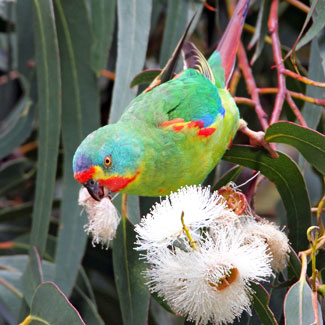World's only migratory parrots in peril
 Tuesday, May 11, 2010 at 11:30
Tuesday, May 11, 2010 at 11:30  Orange-bellied parrot (Photo: Chris Tzaros, Birds Australia) Two Australian parrots migrate annually over Bass Strait — a voyage that threatens their survival.
Orange-bellied parrot (Photo: Chris Tzaros, Birds Australia) Two Australian parrots migrate annually over Bass Strait — a voyage that threatens their survival.
When we think of animal migration, images come to mind of great herds of caribou moving across the tundra or of the dust rising on Africa's Serengeti under the hooves of thousands of wildebeest. But the true champions of migration are the birds.
Every year hundreds of millions of birds from massive storks and geese down to the tiniest hummingbird take to the wing on a journey into the unknown. The Arctic tern makes an annual pilgrimage from the Arctic Circle to the edge of the Antarctic pack ice and back again. And last year a ruddy turnstone (a dumpy shorebird about half the size of a chicken) was tracked on a 27,000 km round trip from Australia to Siberia and Alaska, at times flying for six days non-stop across the oceans.
This last weekend on World Migratory Bird Day (9 May), people gathered around the globe to celebrate the wonder of bird migration. Few would have had parrots in their thoughts, but here in Australia we have the world's only two long-distance migratory parrots.
Both the swift parrot and the orange-bellied parrot breed in Tasmania in the summer and then make their way across the treacherous waters of Bass Strait to spend winter on the mainland. Avoiding a chilly Tasmanian winter might seem like a good survival strategy, but it is fraught with danger. Along the way the birds must face the potential of bad weather blowing them off course, or, after arriving at their destination exhausted and starving, finding poor conditions and little food.
 Swift Parrot (Photo: Chris Tzaros) Sadly, both species of parrot are counted amongst our most threatened birds. There are multiple challenges when trying to conserve migratory species as the habitats they rely on aren’t confined to any one location. Migratory birds like these two parrots need good conditions not just in their places of origin and destination, but in all their stops along the way.
Swift Parrot (Photo: Chris Tzaros) Sadly, both species of parrot are counted amongst our most threatened birds. There are multiple challenges when trying to conserve migratory species as the habitats they rely on aren’t confined to any one location. Migratory birds like these two parrots need good conditions not just in their places of origin and destination, but in all their stops along the way.
In Tasmania, the swift parrot nests in mature, hollow-bearing trees that are in close proximity to their preferred food source — the blossom of eucalypts such as the Tasmanian blue gum. The trouble is, the flowering of the trees on which parrots rely is patchy — areas that produce profuse nectar in year may not do so for another five, forcing the parrots to move around even within their breeding range. On the mainland the swift parrot usually heads for the woodlands of the interior of Victoria and the southern half of New South Wales but, in years of drought when the trees don’t flower, they are forced to keep on moving, sometimes so far north they cross the border into Queensland.
For the Orange-bellied parrot, available habitat is even more restricted. Now confined to one tiny patch of heathy woodland in the remote south west of Tasmania, the scraps of suitable coastal saltmarsh that they rely on to get them through the winter are stretched between Wilson’s Promontory and the Coorong in South Australia. Such is the struggle for the orange-bellied parrot that there are now less than 50 birds surviving in the wild, and it is predicted to be extinct within the next five years.
When one considers that neither of these beautiful green parrots is much longer than a willie wagtail, the feat of their annual pilgrimage is simply amazing. But if they are to be able to make their journey in the future, they, like the millions of other migratory birds, need our help to protect their various habitats.
We often hear about how we are all connected in this world; more than anything else in nature, the flights of migratory birds makes this connection real. Their journeys teach us that what we do in our patch can directly affect what happens in somebody else’s.

